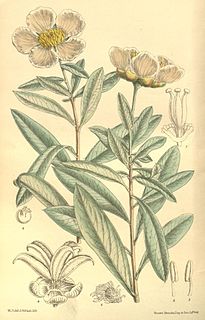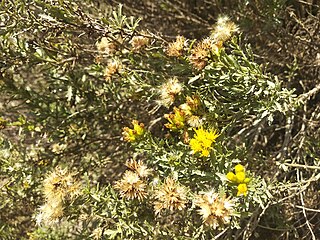
A cactus is a member of the plant family Cactaceae, a family comprising about 127 genera with some 1750 known species of the order Caryophyllales. The word cactus derives, through Latin, from the Ancient Greek word κάκτος (káktos), a name originally used by Theophrastus for a spiny plant whose identity is now not certain. Cacti occur in a wide range of shapes and sizes. Although some species live in quite humid environments, most cacti live in habitats subject to at least some drought. Many live in extremely dry environments, even being found in the Atacama Desert, one of the driest places on Earth. Because of this, cacti show many adaptations to conserve water. For example, almost all cacti are succulents, meaning they have thickened, fleshy parts adapted to store water. Unlike many other succulents, the stem is the only part of most cacti where this vital process takes place. Most species of cacti have lost true leaves, retaining only spines, which are highly modified leaves. As well as defending against herbivores, spines help prevent water loss by reducing air flow close to the cactus and providing some shade. In the absence of true leaves, cacti's enlarged stems carry out photosynthesis. Cacti are native to the Americas, ranging from Patagonia in the south to parts of western Canada in the north—except for Rhipsalis baccifera, which also grows in Africa and Sri Lanka.

Baccharis is a genus of perennials and shrubs in the aster family (Asteraceae). They are commonly known as baccharises but sometimes referred to as "brooms", because many members have small thin leaves resembling the true brooms. They are not at all related to these however, but belong to an entirely different lineage of eudicots. B. halimifolia is commonly known as "groundsel bush", however true groundsels are found in the genus Senecio.

Crossosomataceae is a small plant family, consisting of four genera of shrubs found only in the dry parts of the American southwest and Mexico. This family has included up to ten species in the past, although as of 2021 six species are still recognised. Crossosoma are shrub-like plants which can vary from being 50 cm to 5 meters tall, with small alternating leaves that surround the stem, or leaves clustered in small spurts (fascicles). Apacheria, however, has opposite leaves. Crossosoma has usually white flowers that are generally bisexual and have 5 petals attached to a nectary disk, but in Velascoa the flowers are campanulate and have an extremely reduced nectary disk.

Isocoma, commonly called jimmyweed or goldenweed, is a genus of North American semi-woody shrubs in the family Asteraceae. It is found in the semi-arid areas of Southwestern United States and Mexico.

Isocoma tenuisecta, commonly called burroweed, shrine jimmyweed, or burrow goldenweed is a North American species of small, flowering perennial herbs in the family Asteraceae. It is native to Arizona, New Mexico, and Sonora.
Isocoma pluriflora, commonly called southern jimmyweed or southern goldenbush, is a North American species of flowering perennial herbs in the family Asteraceae. It grows in northern Mexico and in the southwestern and south-central United States.

Isocoma acradenia is a North American species of flowering plant in the family Asteraceae known by the common name alkali goldenbush.
Isocoma arguta is a rare species of flowering plant in the family Asteraceae known by the common name Carquinez goldenbush. It has been found only in Solano and Contra Costa Counties in California, where it grows in the Sacramento-San Joaquin River Delta. It is a resident of Suisun Marsh. It thrives on alkali flats and other mineral-rich soils.

Isocoma menziesii is a species of flowering plant in the family Asteraceae, known by the common name Menzies' goldenbush.

Fouquieria is a genus of 11 species of desert plants, the sole genus in the family Fouquieriaceae. The genus includes the ocotillo and the Boojum tree or cirio. They have semisucculent stems with thinner spikes projecting from them, with leaves on the bases spikes. They are unrelated to cacti and do not look much like them; their stems are proportionately thinner than cactus stems and their leaves are larger.

Isocoma veneta is a Mexican species of plants in the family Asteraceae. It is widespread across much of Mexico from Coahuila and Tamaulipas south as far as Oaxaca and Veracruz.
Isocoma azteca, common names Apache jimmyweed or Aztec goldenbush, is a plant species native to Arizona and New Mexico. It grows on sandy to clay soils, often with Atriplex sp., at elevations of 1,500–1,800 m (4,900–5,900 ft).
Isocoma tomentosa is a rare Mexican species of plants in the family Asteraceae. It has been found only in the state of Chihuahua in northern Mexico. As of 1991, it was known from only one location near a hot spring southeast of Chihuahua City.
Isocoma rusbyi, the Rusby's goldenbush, is a North American species of plants in the family Asteraceae. It has been found in the States of Arizona, Utah, New Mexico, and Colorado in the southwestern United States. Some of the populations lie inside Grand Canyon and Petrified Forest National Parks, others in the Glen Canyon National Recreation Area.
Isocoma humilis, common names Zion goldenbush or Zion jimmyweed, is a rare North American plant species in the family Asteraceae. It has been found only in southern Utah in the United States. Some of the populations lie inside Zion National Park.
Isocoma hartwegii is a Mexican plant species in the family Asteraceae. It has been found in the states of Jalisco, Zacatecas, Aguascalientes, Hidalgo, Guanajuato, and San Luis Potosí.
Isocoma gypsophila is a Mexican plant species in the family Asteraceae. It has been found in the States of Zacatecas and Nuevo León.
Isocoma felgeri is a rare Mexican plant species in the family Asteraceae. It has been found in the State of Sonora, in desert scrub near Bahía de Kino.
Isocoma drummondii, the Drummond's goldenbush, is a North American plant species in the family Asteraceae. It has been found on both sides of the Río Grande, in Tamaulipas and in southern Texas.
Isocoma coronopifolia, the common goldenbush, is a North American plant species in the family Asteraceae. It has been found on both sides of the Río Grande, in Tamaulipas, Coahuila, Nuevo León, Chihuahua, and southern Texas.







